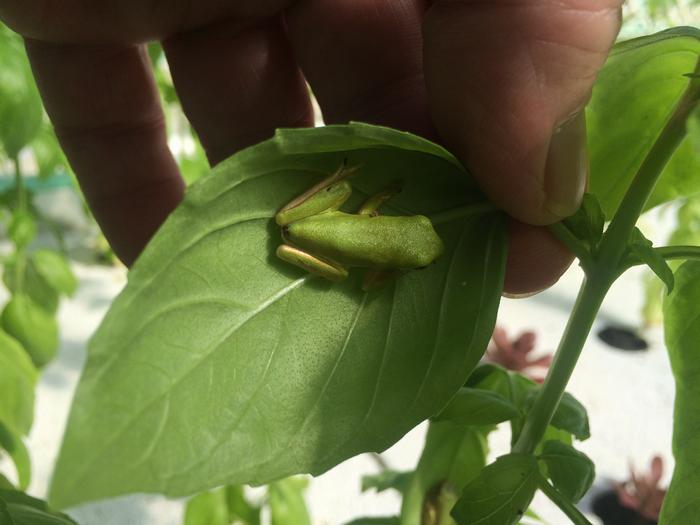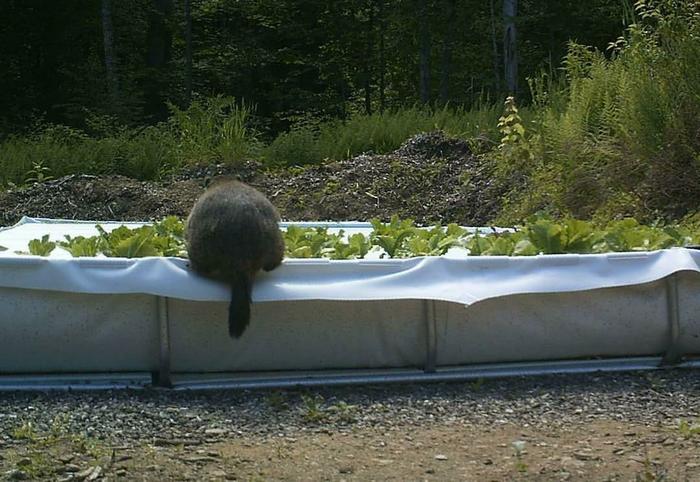How To Win The War On Bugs, Part 2 (or Aquaponic Pest Control)
When we first started our aquaponics system, I was utterly amazed by the fact there were simply no bugs! I had always heard about how hard it was for organic farmers to fight pests,and I was excited to find out that it was easier than I thought. In fact, I went so far as to mention this to a good friend, Donna Mitts, who had been an organic gardener her whole life, and even teaches it at a local school. She threw her head back and laughed out loud, then said, “Your farm is so new they just haven’t found you yet!” Did she ever turn out to be right!
(Below) Actually NOT a system pest! This little frog will eat its weight every day in insect pests; and will do a lot of your job of pest control for you. You just have to make certain not to package any of this basil with “extra protein included” so to speak!
Here in Hawaii we jokingly talk about something called the “coconut wireless”, which refers to how quickly news spreads. Turns out the pests have their own coconut wireless, because first just a few showed up, and they sent out the word to all their friends and family. About a week later, all of a sudden we were absolutely overrun with bugs, thousands and thousands, and I had almost no clue what to do. The thousands of aphids I could identify, and hundreds of caterpillars, but I had no idea where they had all come from. And I did not even know what a lot of them were! There are five or six kinds of bugs I had never seen before, so I called Donna again, and she came over to check out my new bug zoo.
In those early days, I remember seeing what I thought were cute little light green butterflies flying happily around our plants, landing gently on the leaves now and again. I learned from Donna that these pretty flying insects were in fact cabbage moths, and every time they landed, they were laying their eggs. Aha! That’s where all the caterpillars had come from! Donna also identified solanaceous leafhoppers that were sucking the life out of my tomatoes, coating every stem, and that looked just like rose thorns. She showed me leaf miners, which were leaving little trails through the leaf. She pointed out tiny little white flies that were leaving behind a terrible, sticky mess.
She told me about some organic solutions, but she had no clue whether those solutions could be safely used with our fish. So, I began my research, and decided to start by learning to understand insects better.
First, The Really BIG Bugs!
Insects are not the only things that will eat your vegetables. A good rule of thumb to use, to understand if a particular vegetable will be susceptible to predation, is to ask yourself: “would I eat an uncooked bowl of this myself?”. If the answer is no, as with green onions, leeks, garlic, and mint, then there will be minimal or no pest predation on that vegetable.
If the answer is yes, then everyone else that walks by your farm will want to eat it too! This includes deer, bear, squirrels, rabbits, opossums, raccoons, pigs, badgers, horses and cows, mice, rats, birds, gophers, and on and on. The first line of defense against these animals is a good 4-foot-tall hogwire fence on good posts, with 2-foot wide small poultry wire installed on the bottom over the hogwire and a couple of strands of electrically charged “hot wire” on the outside of the fence at the top, spaced about 4 inches apart vertically.
The bottom of the fence needs to be staked down solidly every ten feet or so with a 16-inch long, U-shaped piece of quarter-inch or 3/8-inch steel bar that you’ve hammered into the ground; this will prevent hogs from nosing under and bulldozing the fence out of their way. The chicken wire will stop the badgers, and most of the gophers from just walking in. The hot wire at the top of the fence will “peel off” the possums and raccoons that try to climb the fence; and will keep bears, horses and cows out.
(Below) Yes, that’s a woodchuck butt you’re looking at! And she is NOT just sipping the water; everything that tastes good to you tastes good to her, too. Notice the lack of any fencing around this aquaponics plot next to a shaded woodland area.
Next, a good dog that is chained up right inside the fence in a kennel will help keep most of these animals away; both the dog’s scent and the dog barking at intruders will warn them off; unless your aquaponic operation is huge, then predators may come in on one side and eat while the dog is sleeping on the other side. If you decide not to have a dog, for whatever reason, and you have deer, then your fence needs to be around 10 feet high. Deer can easily clear a 6-foot high fence; and we’ve seen deer clear an 8-foot high fence; just depends how hungry they are and how good the food smells to them. Deer will also just jump over “hot wire” fences without ever touching the wire once, so they’re useless for deer, unless you try the following:
There’s a super easy way to deal with deer, offered by a student at one of our courses: wrap some aluminum foil around the hot wire every ten feet or so, in the shape of a playing card folded 90 degrees, placed upside down, and “crimped” with your fingers over the wire (remember to turn the fence off before you do this! J). We’ll call this our “foil playing card”, or FPC. At each FPC, take a finger-full of peanut butter and wipe it off on the underside of the foil. Putting the peanut butter on the underside keeps it from getting washed off by snow and rain. What happens next?
A deer comes up to the foil, drawn by the irresistible smell of the peanut butter (they love it, say hunters, who often use it for a deer lure!). The deer noses up to the FPC, and either licks it or sniffs it, making nose or tongue contact for that critical second. The next moment, the deer goes through the roof and is the biggest brown and white streak you ever saw, going 180 degrees from the fence!
The best part? It seems you only need to get one deer, and that one tells all the others; they stay far away from your fence for a long time. And the only thing you need to do is patrol your fence every once in a while and renew the peanut butter! (remember to turn it off!).
What’s the biggest, smartest pest you will have to deal with? People hopping your fence to steal your fish and vegetables! Agricultural theft is one of the biggest costs of doing business that some small farmers face. So that dog better be big, well trained not to take handouts from strangers, and look fierce! Living on the place yourself is also a real deterrent to theft.
Leave a Reply